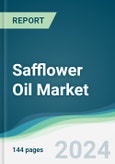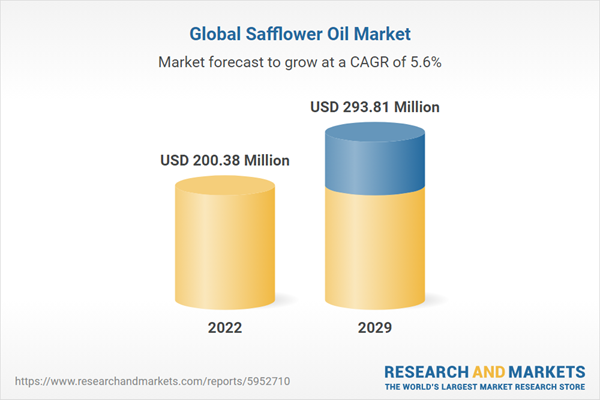The safflower oil market is expected to experience a CAGR of 5.62% throughout the forecast period, reaching a market size of US$293.812 million by 2029. This represents a substantial increase from US$200.384 million recorded in 2022.
The safflower oil market has witnessed substantial growth in recent years, primarily driven by its versatile applications in the food processing and cosmetics/pharma sectors. As a key player in the edible oil segment, safflower oil has gained traction due to its high nutritional value, rich omega-6 fatty acid content, and potential health benefits. In the food processing industry, safflower oil is preferred for its light flavor, high smoke point, and heart-healthy properties, making it an ideal choice for cooking, frying, and salad dressings. The rising consumer awareness regarding the importance of a healthy lifestyle has further fueled the demand for safflower oil as a cooking medium. Moreover, the cosmetic and pharmaceutical industries have recognized the potential of safflower oil for various applications. Safflower oil's moisturizing and antioxidant properties make it a sought-after ingredient in skincare and haircare products. Its ability to promote skin health and address issues like dryness and inflammation has contributed to its incorporation in a wide range of cosmetics. Additionally, the pharmaceutical sector utilizes safflower oil in the formulation of medicinal products, owing to its potential anti-inflammatory and cholesterol-lowering effects.The global market for safflower oil is also witnessing growth due to increasing consumer preference for natural and plant-based products. As health-conscious consumers seek alternatives to traditional cooking oils and synthetic ingredients in personal care products, safflower oil stands out as a natural and beneficial option. Furthermore, ongoing research and development activities aimed at exploring new applications and enhancing the extraction and processing methods are expected to drive innovation in the safflower oil market, fostering its sustained growth. Overall, the combination of its nutritional benefits, versatile applications, and alignment with consumer preferences positions safflower oil as a key player in the expanding edible oil and cosmetic/pharma markets.
Focus on healthy lifestyle propels the global market.
The surge in the demand for safflower oil can be significantly attributed to the increasing emphasis on adopting healthier lifestyles. Consumers worldwide are becoming more health-conscious, seeking dietary choices that align with their well-being goals. Safflower oil, recognized for its heart-healthy properties, has emerged as a preferred option in response to this growing trend. Its high content of monounsaturated and polyunsaturated fats, particularly omega-6 fatty acids, contributes to its positive impact on cardiovascular health. As individuals prioritize healthier cooking alternatives, safflower oil stands out due to its low saturated fat content and high smoke point, making it suitable for various culinary applications. The oil's nutritional profile, which includes vitamin E and other antioxidants, further adds to its appeal for health-conscious consumers. This heightened awareness of the importance of a balanced diet and the role of cooking oils in overall health has spurred an uptick in the demand for safflower oil as a cooking medium. Safflower oil comprises the following fatty acids: linoleic (53.8%-84%), oleic (9.5%-91%), palmitic (4.9%-16.1%), stearic (1.7%-6.3%), linolenic (0%-1.5%), myristic (0%-0.2%), palmitoleic (0%-0.5%), arachidic (0%-1.9%), behenic (0%-0.7%), eicosaenoic (0%-0.2%), lignoceric (0%-0.8%), lauric (0%-0.07%), and heptadecanoic (0%-0.04%). Additionally, the cosmetic and pharmaceutical industries are capitalizing on the trend toward healthier living by incorporating safflower oil into their products. As consumers seek natural and plant-based alternatives in skincare and haircare, safflower oil's moisturizing and antioxidant properties make it a valuable ingredient. Moreover, ongoing research linking safflower oil to potential health benefits, such as anti-inflammatory effects, has fueled its integration into pharmaceutical formulations.In essence, the increasing demand for healthier lifestyles is a major growth factor propelling the safflower oil market. As consumers prioritize well-being, safflower oil's nutritional advantages, versatility, and alignment with health-conscious choices position it as a key player in the expanding market for edible oils and natural ingredients in cosmetics and pharmaceuticals. This consumer-driven shift toward healthier living is expected to sustain and drive the safflower oil market growth in the foreseeable future.
North American is expected to witness significant growth in the safflower oil market
The growing shift towards low-fat food consumption and healthier lifestyle adoption has bolstered the need for effective edible oil. Various health benefits provided by safflower oil such as lowering cholesterol, improving sugar & blood pressure, and overall metabolism, make such edible oil an ideal choice in food processing applications. Furthermore, the booming end-user demand has positively impacted the overall safflower production in the US which has paved the way for new market opportunities. According to the “Annual Crop Summary 2022” released by the United States Department of Agriculture in January 2023, total safflower production in the United States reached 164 million pounds which signified a 22% increase over 2021’s production scale of 135 million pounds, while the nation’s average yield per acre stood at 1,213 pounds which signified an increase of 209 pounds over 2021. Moreover, as per the same source states such as Montana also experienced positive growth in production where the average yield increased 20 pounds per acre in comparison to 2021, and the harvested acres grew by 3,000 acres. Furthermore, the growing self-awareness has increased the demand for skin-care products in the USA, which is anticipated to propel the market demand for safflower oil since its antioxidant and anti-inflammatory properties prevent skin inflammation and improve overall softness.The growing prevalence of chronic diseases such as cardiac disease, and diabetes coupled with the booming old-age population has provided a new growth prospect. According to the Centers for Disease Control and Prevention (CMS), approximately 6.2 million adults in the United States have heart disease. According to CMS's “Mapping Medicare Disparities” tool, in 2022, 12% of the people enrolled in Medicare FFS (Fee-For-Service) had a diagnosis of heart failure. Major market players such as Adam Groups have emphasized promoting healthier diet consumption owing to which their “Refined Olefin Safflower Oil” has low saturated fats and is ideal for cooking, frying & baking.
Segmentation:
By Grade:
- High-oleic
- High-linoleic
By Application:
- Dietary
- Non-Dietary
By End-User:
- Food Processing
- Cosmetics and pharmaceuticals
- Paints and coatings
- Others
By Distribution Channel:
- Online
- Offline
By Geography
- North America
- USA
- Canada
- Mexico
- South America
- Brazil
- Argentina
- Others
- Europe
- Germany
- France
- United Kingdom
- Italy
- Others
- Asia Pacific
- China
- Japan
- India
- South Korea
- Taiwan
- Thailand
- Indonesia
- Others
Table of Contents
Companies Mentioned
- Merck KgaA
- Connoils LLC
- Adams Group
- Centra Foods
- Rakesh Sandal Industries
- Aayudhara
- Gustav Hees Oleochemische Erzeugnisse GmbH
- Henry Lamotte Oils GmbH
- Medikonda Nutrients
- Montana Dakota Brands
- Catania Spagna
Table Information
| Report Attribute | Details |
|---|---|
| No. of Pages | 144 |
| Published | February 2024 |
| Forecast Period | 2022 - 2029 |
| Estimated Market Value ( USD | $ 200.38 Million |
| Forecasted Market Value ( USD | $ 293.81 Million |
| Compound Annual Growth Rate | 5.6% |
| Regions Covered | Global |
| No. of Companies Mentioned | 11 |









